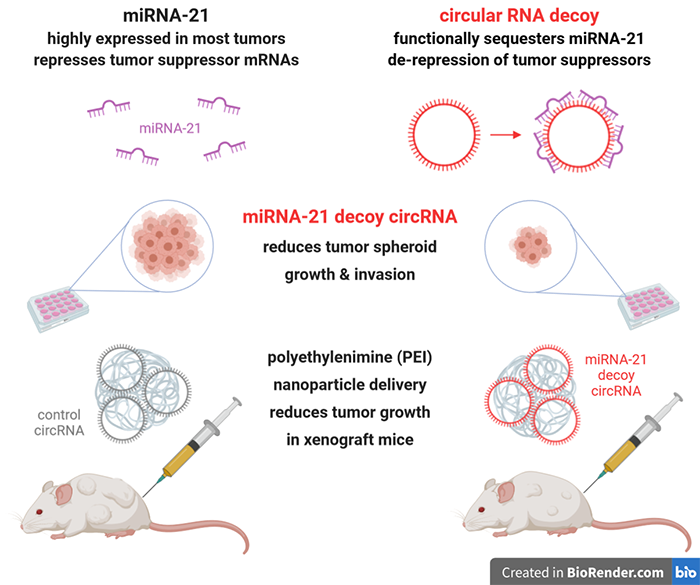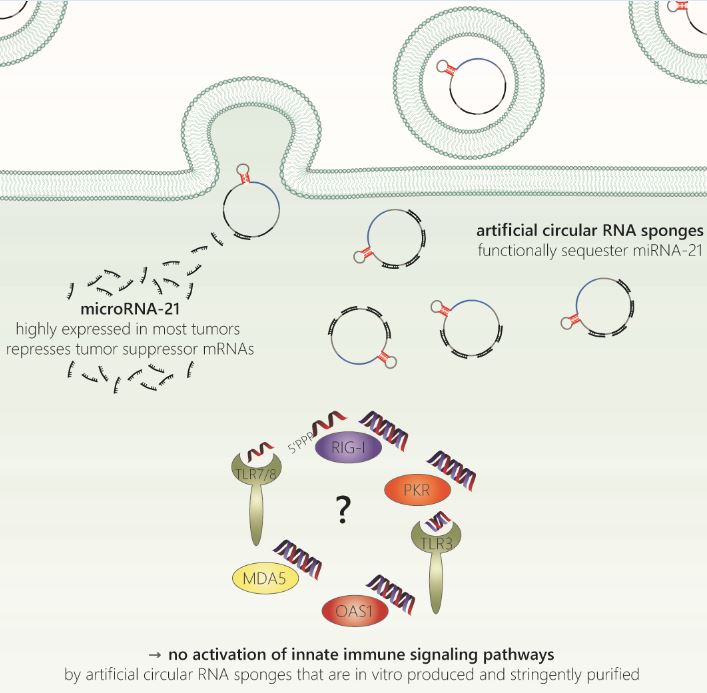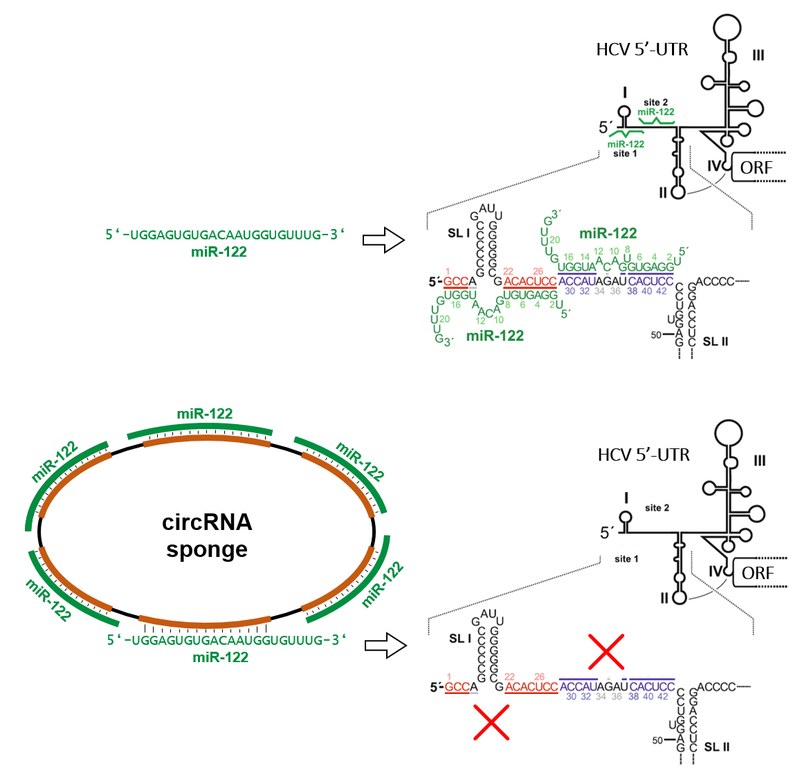Circular RNA sponges as a novel tool in molecular medicine and biology
...we are developing artificial circular RNAs that function as molecular sponges
Circular RNAs (circRNAs) have recently emerged as a new class of ubiquitously expressed mainly non-coding RNA. They are created by the canonical splicing machinery in a process referred to as “back-splicing”, where a donor splice site is spliced to an upstream instead of a downstream acceptor site. Two endogenous circRNAs, CDR1as/ciRS-7 and SRY, have been shown to contain conserved microRNA (miRNA)-binding sites and function as miRNA sponges in vivo. Due to their elevated stability compared to linear RNA, circRNAs may be an interesting tool in molecular biology.
Synthetic circular miRNA-21 RNA decoys enhance tumor suppressor expression and impair tumor growth in mice.

Since naturally occurring circRNAs efficiently impair miRNA functions, synthetic circRNAs may serve as potent agents for miRNA inhibition. Their therapeutic effect critically relies on (i) the identification of optimal miRNA targets, (ii) the optimization of decoy structures and (iii) the development of efficient formulations for their delivery to be used as a drug. In a recent study, we extensively explored the functional relevance of miRNA-21 in cancer cells (with Stefan Hüttelmaier, University Halle). Analyses of cancer transcriptomes reveal that miRNA-21 is the by far most abundant miRNA in human cancers. Deletion of the MIR21 locus in cancer-derived cells identifies several direct and indirect miRNA-21 targets, including major tumor suppressors with prognostic value across cancers.
To impair miRNA-21 activities, we evaluate artificial circRNA sponges produced by in vitro ligation containing four repetitive binding elements. In cancer cells, these decoys efficiently elevate tumor suppressor expression and impair tumor cell vitality, as well as tumor spheroid growth in 3D cell cultures.
For their in vivo delivery, we for the first time evaluate the formulation of circRNA decoys in polyethylenimine (PEI)-based nanoparticles (with Achim Aigner, University Leipzig). We demonstrate that PEI/circRNA nanoparticles lead to a significant inhibition of tumor growth in a lung adenocarcinoma xenograft mouse model via the upregulation of tumor suppressor expression. These findings introduce nanoparticle-delivered circular miRNA decoys as a powerful potential therapeutic strategy in cancer treatment.
We have published a detailed protocol for production and purification of artificial circular RNA sponges for application in molecular biology and medicine in Methods and Protocols. (Article Link)
What goes around comes around: artificial circular RNAs bypass cellular antiviral responses.

As a novel and promising antisense approach, artificial circular RNA sponges (ciRS) were shown to efficiently impair oncogenic and pro-proliferative miR-21 functions in vivo. What remained controversial, was the question whether circRNAs provoke innate immune responses.
The cellular innate immune system is able to detect foreign RNA via sensory molecules like RIG-I, PKR or TLR7/8. This leads to the activation of various signaling pathways resulting in the induction of cytokines, chemokines and interferons. In a recent study, we addressed the antiviral immunogenicity of the artificial ciRS previously used to inhibit miR-21 functions, in highly immuneresponsive A549 cells.
Artificial ciRS containing either a randomized control sequence (ciRS-21-random) or four bulged miR-21 binding sites (ciRS-21-bulge) were produced in vitro, and stringently purified by polyacrylamide-urea gel extraction. When transfected using liposomes, these ciRS bypassed the cellular antiviral immune response as evident from the levels of downstream effector mRNAs. Only a highly double-stranded circRNA containing a randomized self-complementary sequence of 48 bp, stimulated antiviral responses comparable to polyinosinic:polycytidylic acid (Poly(I:C)) in a time- and dose-dependent manner. Immunoblotting revealed that ciRS-21-ds, but not ciRS-21-random and ciRS-21-bulge, induced the activation of the double-stranded RNA (dsRNA) sensory protein PKR.
Functional sequestration of microRNA-122 from Hepatitis C Virus by circular RNA sponges.

Conrad, Niepmann (2014) Arch Virol, modified
Miravirsen, the first anti-miRNA drug, functionally sequesters miRNA-122 and decreases Hepatitis C Virus (HCV) titer to non-detectable levels in patients after a four-week subcutaneous injection. miRNA-122 is essential for HCV propagation and protects the single-stranded RNA genome from exonucleolytic degradation and enhances HCV translation by binding two adjacent sites at its 5’-end. We designed artificial miRNA-122 sponges that, when transfected as an in vitro transcribed and ligated circRNA, can be used to sequester miRNA-122 from HCV RNA. These circRNAs are more stable compared to their linear counterparts and found both in the cytoplasm and in the nucleus. In an infectious HCV cell culture system, viral proteins are reduced to non-detectable levels, similarly as with a Miravirsen-like antisense oligonucleotide.
Our results demonstrate that artificial circRNA sponges are a promising tool in molecular medicine and biology with a wide range of potential applications. We have created a universal circularization hub for creation of circRNA sponges containing the highly repetitive miRNA binding sites. We currently aim to develop circular RNA sponges for other targets and to use them to sequester disease-relevant miRNAs and RNA-binding proteins also in other systems and disease models.
-
Breuer J, Barth P, Noe Y, Shalamova LA, Goesmann A, Weber F, Rossbach O. What goes around comes around: artificial circular RNAs bypass cellular antiviral responses. Molecular Therapy - Nucleic Acids. 2022 Apr 27. PMID: 35497503 (Article Link)
-
Müller S*, Wedler A*, Breuer J*, Glaß M, Bley N, Lederer M, Haase J, Misiak C, Fuchs T, Ottmann A, Schmachtel T, Shalamova LA, Ewe A, Aigner A*, Rossbach O*, Hüttelmaier S* Synthetic circular miR-21 RNA decoys enhance tumor suppressor expression and impair tumor growth in mice. NAR Cancer. 2020 Jul 30: Volume 2, Issue 3, September 2020, zcaa014. PMID: 34316687 (Article Link)
-
Breuer J, Rossbach O. Production and purification of artificial circular RNA sponges for application in molecular biology and medicine. Methods and Protocols. 2020 May 22;3(2):42.PMID: 32466614 (Article Link)
-
Rossbach O. Artificial circular RNA sponges targeting microRNAs as a novel tool in molecular biology. Molecular Therapy - Nucleic Acids. 2019 Jul 19;17:452-454. PMID: 31330496 (Article Link)
-
Jost I*, Shalamova LA*, Gerresheim GK, Niepmann M, Bindereif A, Rossbach O. Functional sequestration of microRNA-122 from Hepatitis C Virus by circular RNA sponges. RNA Biology. 2018 Feb 28:1-8. PMID: 29486652 (Article Link)
-
Schneider T, Schreiner S, Preußer C, Bindereif A, Rossbach O. Northern Blot Analysis of Circular RNAs. Methods in Molecular Biology. 2018 Jan; 1724:119-133. PMID: 29322445 (Article Link)
-
Schneider T, Hung LH, Schreiner S, Starke S, Eckhof H, Rossbach O, Reich S, Medenbach J, Bindereif A. CircRNA-protein complexes: IMP3 protein component defines subfamily of circRNPs. Scientific Reports. 2016 Aug 11; 6:31313. PMID: 27510448 (Article Link)
-
Starke S, Jost I, Rossbach O, Schneider T, Schreiner S, Hung LH, Bindereif A. Exon circularization requires canonical splice signals. Cell Reports. 2015 Jan; 10(1):103-11. PMID: 25543144 (Article Link)
-----
(* these authors contributed equally / co‐corresponding authors)
